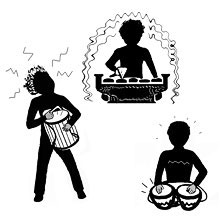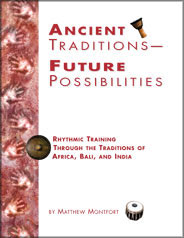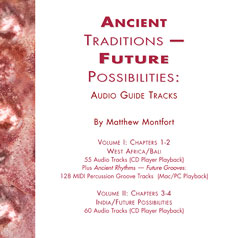Ancient Future Times: Beat's by the Books
September 2017 Issue:
Where's the Beat?
•West Africa, Bali, and India, birthplaces of polyrhythm, gamelan, and tala.
Ancient Future Performs Free Library Concert Series
•World Guitar Pioneer Matthew Montfort with Arabic Percussion Virtuoso Antoine Lammam or Tabla Virtuoso Vishal Nagar
Where's the Beat?
A. West Africa, Bali, and India, birthplaces of polyrhythm, gamelan, and tala.
B. Within every performer, where musical dreams are made.
C. In a rhythm training manual by Matthew Montfort called Ancient Traditions – Future Possibilities.
D. In the new companion set from Ancient Traditions – Future Possibilities: Audio Guide and MIDI Groove Tracks from the Traditions of Africa, Bali, and India.
E. Through world rhythm workshops and Skype study with Matthew Montfort.
F. All of the above.
If you answered "all of the above," you are well on your way to finding the beat! Read on to find out how a training manual on the rhythms of Africa, Bali and India can help performers of all types reach their musical dreams, enable listeners to get more out of music, and is now bringing these ancient rhythms into the grooves of the future with the release of an audio companion edition for digital audio workstations, sequencers, computers, tablets, smartphones, CD players and other gizmos!
The Beginning, the Beat, the BookAncient Traditions – Future Possibilities: Rhythmic Training Through the Traditions of Africa, Bali and India. By Matthew Montfort. Mill Valley: Panoramic Press, 1985. ISBN 0-937879-00-2.
This classic "world beat bible" by Matthew Montfort takes the student on a musical voyage through the ancient rhythmic traditions of Africa, Bali, and India with a series of exercises that require no instruments to perform. Interesting, imaginative and fun, these rhythm exercises will be of immense help to all music lovers, not just percussionists.
The New Guides and GroovesAncient Traditions – Future Possibilities: Audio Guide and MIDI Groove Tracks from the Traditions of Africa, Bali, and India. By Matthew Montfort. Ancient Future Music (AF-0001, 2005. V 4.0, 2017). New Preview Release!
This new downloadable companion set of MP3 audio guide and MIDI groove tracks of the exercises in the book Ancient Traditions – Future Possibilities is set up for playback on Mac and PC computers, tablets, and smartphones. The tracks are also available on a CD/CD-ROM set. The material is presented in two complimentary formats: audio guide tracks and MIDI groove tracks.
The Audio Guide TracksAncient Traditions – Future Possibilities: Audio Guide Tracks is a set of 115 audio guide tracks of the exercises in Ancient Traditions – Future Possibilities that enable learning by ear.
The MIDI Groove TracksAncient Rhythms – Future Grooves: MIDI Percussion Groove Tracks from the Traditions of Africa, Bali, and India is a complete set of 128 MIDI tracks that playback in Standard MIDI File compatible web browsers. For greater control or for use as rhythm tracks in audio productions, load them into a MIDI sequencer app (Mac, PC, iOS, Android, etc.) to loop tracks, change the tempo, or listen to individual parts. The files come arranged for General MIDI percussion and can be remapped to other instruments using the included MIDI maps.
The Eve Orchestra of West AfricaThe Eve people of the island town of Anyako off the coast of Southeastern Ghana have developed a music rich in polyrhythmic interplay, such as in the drum music of takada, a dance and drumming club developed by the Eve women. The instruments of their percussion orchestra are detailed in the West African section of Ancient Rhythms – Future Grooves.
The Interlocking Rhythms of Balinese GamelanA gamelan is an ensemble normally composed primarily of percussion. In Bali, orchestras of tuned gongs, bronze kettles, bronze metallophones, bamboo xylophones, drums, cymbals, and flutes fill the night air with animated music. Melodic parts interlock, divided in such a way that musicians play alternate notes to form the melody line. These interlocking parts, known as kotèkan, require cooperation and a keen sense of rhythm to perform. The Balinese section of Ancient Rhythms – Future Grooves details the music and instruments of the Gamelan Semar Pegulingan and other ensembles.
The Rhythmic Cycles of IndiaThe perception of the cyclic nature of life is reflected in Indian classical music through the device oftala,a recurring time-measure or rhythmic cycle. There are two different traditions in Indian classical music, the Carnatic music of South India and the Hindustani music of North India.
The tabla is a North Indian drum set comprised of two drums with goat-skin heads. For every sound on the drum there is a corresponding syllable. These syllables are known as bols. Each North Indian tala has a theka, a standard set of bols that identify the rhythmic cycle. The MIDI files of these thekas make excellent groove tracks for creating compositions or practicing. The North Indian section of Ancient Rhythms – Future Grooves features a full explanation of the tabla bols complete with audio links to tabla samples of each bol, and files for VSTi instruments and GarageBand that remap the MIDI files to the included tabla samples.
The mridangam is a South Indian two-headed barrel drum made of jackwood with goatskin heads. South Indian drumming has a language all of its own known as solkattu. For the sounds produced by the mridangam, there are corresponding syllables known as konokol. The South Indian section of Ancient Rhythms – Future Grooves features an explanation of the konokol syllables used in the solkattu compositions that are presented.
The Workshops and Skype LessonsMatthew Montfort offers instruction based on Ancient Traditions – Future Possibilities through online lessons via Skype and rhythm workshops at conservatories, public schools, and resorts.
The Quotes"You can view this deceptively slim masterwork from a few different angles: as a friendly yet serious appetizer on three of the most sophisticated rhythm systems on earth; a chance to work on your rhythmic sight reading; a three-culture dip with matching mp3s for your ears; a gateway to exotic spices, complete with MIDI files, for your songwriting or drumming; or a fun way to organically digest complex time signatures. No matter how you slice it, this scholarly labor of love is packed with rich flavors for those patient enough to harvest them." – E.E. Bradman, Bass Player Magazine
"You've heard Afro-Pop, sitar, gamelan and world music for years. But do you know what they are and how they work? Better yet, would you like to play those twisted cross-rhythms and melodies? In Ancient Traditions – Future Possibilities, Matthew Montfort, a founding member of the world music band Ancient Future, has put together the book for people who want to dig into world music with both hands. Wherever possible, Montfort has provided beat counts alongside the standard musical notation so even if you can't read music, you can still learn the rhythms." – Richard Kadrey, San Francisco Chronicle
"A hands-on exploration of Balinese, African, and Indian rhythms that should appeal to all musicians. One needn't play percussion instruments, or any instruments at all, for that matter, to use and benefit from the book." – Drums and Drumming
"Very highly recommended for any instrumentalists hoping to expand their rhythmic horizons. If you've never investigated the beautiful clash of African polyrhythm, the incredible interlocking textures of Balinese music, or the complex metric structure of Indian classical music, check out Ancient Traditions – it will blow your mind and deepen your groove." – Guitar Player
"If you're tired of programming your drum machine with the same old 4/4 back-beat, or you want to sharpen your rhythmic chops, this book is highly recommended." – Electronic Musician
The PerformersAncient Traditions – Future Possibilities has been used and admired by many teachers and musicians around the world.
Lou Harrison (1917-2003), prominent composer and founder of the American gamelan movement, called the work "a very useful contribution to musical scholarship."
Reinhard Flatischler, founder of the TaKeTiNa rhythm training process, was an early enthusiast of the method book.
John Bergamo (1940-2013), composer and coordinator of the percussion department at the California Institute of the Arts, found a copy of Ancient Traditions – Future Possibilities when he cleaned out his desk at retirement. As he finally had the time available, he worked his way through it, after which he called the author to thank him for writing it, and encouraged him to write more world music training manuals. One is in the works.
Steve Smith, stellar jazz and rock drummer of Journey fame, went through the book in preparation for a percussion summit with tabla master Zakir Hussain.
Start your own journey to musical excellence with Ancient Traditions – Future Possibilities!
Ancient Future Performs Free Library Concert Series
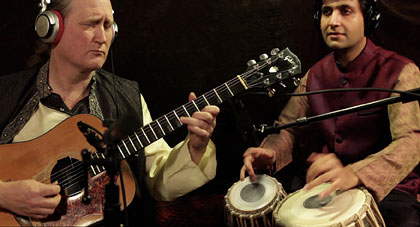
One of the program variations of the trailblazing world fusion music ensemble, Ancient Future, this improvisatory duet features world guitar pioneer Matthew Montfort accompanied by either Arabic percussion virtuoso Antoine Lammam or Indian tabla virtuoso Vishal Nagar. Strains of flamenco, Arabic music, and Indian raga emanate from this duet performing renditions of music from Ancient Future's ground breaking world music recordings as well as many new unreleased works!
These hour long educational concerts by Ancient Future at Sonoma County libraries will introduce the audience to musical concepts from world music such as Indian and Arabic rhythms.
September ConcertsWednesday, September 6, 2017, 6:30 to 7:30 PM, Ancient Future Duet with Matthew Montfort (scalloped fretboard guitar) and Antoine Lammam (Arabic percussion), Petaluma Regional Library, 100 Fairgrounds Drive, Petaluma, CA 94952. Free. Info: 707-763-9801 or visit www.sonoma.lib.ca.us. Facebook Event.
Saturday, September 16, 2017, 2 to 3 PM, Ancient Future Duet with Matthew Montfort (scalloped fretboard guitar) and Antoine Lammam (Arabic percussion), Northwest Santa Rosa Library, 150 Coddingtown Center, Santa Rosa, CA 95401. Free. Info: 707-546-2265 or visit www.sonoma.lib.ca.us. Facebook Event.
Wednesday November 8, 2017, 5 to 6 PM, Ancient Future Duet with Matthew Montfort (scalloped fretboard guitar) and Antoine Lammam (Arabic percussion), Healdsburg Regional Library, 139 Piper Street, Healdsburg, CA 95448. Free. Info: 707-433-3772 or visit www.sonoma.lib.ca.us. Facebook Event.
Wednesday November 8, 2017, 7 to 8 PM, Ancient Future Duet with Matthew Montfort (scalloped fretboard guitar) and Antoine Lammam (Arabic percussion), Windsor Regional Library, 9291 Old Redwood Highway Building 100, Windsor, CA 95492. Free. Info: 707-838-1020 or visit www.sonoma.lib.ca.us. Facebook Event.
Saturday, December 2, 2017, 2 to 3 PM, Ancient Future Guitar and Tabla Duet with Matthew Montfort (scalloped fretboard guitar) and Vishal Nagar (tabla), Sonoma Valley Regional Library, 755 West Napa Street, Sonoma, CA 95476. Free. Info: 707-996-5217 or visit www.sonoma.lib.ca.us. Facebook Event.
Saturday, January 6, 2018, 2 to 3 PM, Ancient Future Duet with Matthew Montfort (scalloped fretboard guitar) and Antoine Lammam (Arabic percussion), Guerneville Regional Library, 14107 Armstrong Woods Rd., Guerneville, CA 95446. Free. Info: 707-869-9004 or visit www.sonoma.lib.ca.us. Facebook Event.
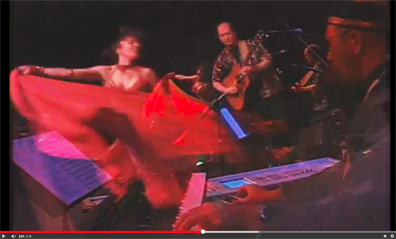
Video of Arabic fusion music by Ancient Future
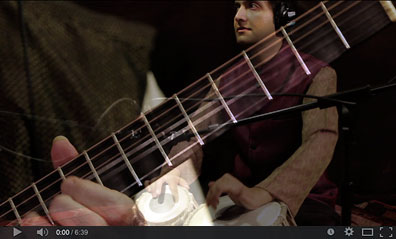
Video of Indian fusion music by Ancient Future



